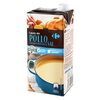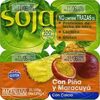E160ai
Pertany a:
Funcions: Color
β-Carotene is an organic, strongly colored red-orange pigment abundant in plants and fruits. It is a member of the carotenes, which are terpenoids -isoprenoids-, synthesized biochemically from eight isoprene units and thus having 40 carbons. Among the carotenes, β-carotene is distinguished by having beta-rings at both ends of the molecule. β-Carotene is biosynthesized from geranylgeranyl pyrophosphate.β-Carotene is the most common form of carotene in plants. When used as a food coloring, it has the E number E160a. The structure was deduced by Karrer et al. in 1930. In nature, β-carotene is a precursor -inactive form- to vitamin A via the action of beta-carotene 15‚15'-monooxygenase.Isolation of β-carotene from fruits abundant in carotenoids is commonly done using column chromatography. It can also be extracted from the beta-carotene rich algae, Dunaliella salina. The separation of β-carotene from the mixture of other carotenoids is based on the polarity of a compound. β-Carotene is a non-polar compound, so it is separated with a non-polar solvent such as hexane. Being highly conjugated, it is deeply colored, and as a hydrocarbon lacking functional groups, it is very lipophilic. - Viquipèdia
Avaluació de l’EFSA: Safety of the proposed extension of use of synthetic Beta-carotene [E 160aii] in foods for special medical purposes in young children (2016-03-18)
País: Espanya - Veure productes coincidents de tot el món
-
Beurre Léger - Président - 250 g

-
Queso fundido sandwich - Hacendado - 200g

-
Mentos fruit - 38 g

-
Bifrutas tropical - Pascual - 330ml

-
Fanta Limón - 330 ml

-
Pan cereales sin gluten - Hacendado - 470g, 14 rebanadas

-
Бисквити покрити с тъмен шоколад - Gullón - 186 g

-
Bifrutas tropical - Pascual

-
Fresa morango - Hacendado

-
Original grated - Violife - 200 g

-
Madeleine - Arenas - 475 g

-
Mantequilla sin lactosa - Hacendado - 250 g

-
Tranches saveur Cheddar - Violife - 200 g

-
Vioblock - Violife - 250 g

-
Hacendado - 400g e
-
Rallado sabor mozzarella - Violife - 200 g

-
Bifrutas tropical - Pascual - 1L

-
Sauce Curry - Carrefour - 350 g

-
Berlina glacé - Mercadona - 200g

-
Salsa Cocktail - Hacendado - 460 ml

-
Bisolan - Agua Solán de Cabras - 330 ml

-
Pommes Frites Sauce - Heinz - 400 ml

-
Palmeritas - Hacendado - 270g (24 unidades)

-
Sabor Tropical - Tang - 30 g

-
Belgas - Saborosa - 220 g

-
Pipocas microondas sabor manteiga - Hacendado - 270g

-
Sauce samouraï - Carrefour - 340 g

-
Mango - Hacendado - 500 g (4 x 125 g)

-
Fanta limón zero azúcares - 330 ml

-
Mantequilla sin lactosa ligera - central lechera asturiana - 250 g

-
Stars - Hacendado - 400 g

-
Chupa Chups - Big Babol -Sugar Free - 16 Big Pieces - 64 g (16 x 4 g)

-
Cookies Sensations Coeur Choco - Milka - 156g

-
Caldo de pollo - La Villa

-
Barritas Chips de chocolate - Chips Ahoy - 140g

-
4 Quesos - Carrefour - 200 g
-
Disfruta Don Simon Piña sin azúcares añadidos

-
Caldo de pollo bajo en sal - Carrefour - 1 L

-
Râpé saveur Emmental - Violife - 200 g

-
Salsa estilo argentino - Hacendado - 285 g

-
Tropical zero - Don Simón

-
Siglitos - 960 ml (12 * 80 ml)

-
Mantequilla ligera - Arias - 235g

-
Zumo D.simon Disfruta Naranja S / Azucar Brik 1L - Don Simón

-
Disfruta Don Simon Naranja sin azúcares añadidos

-
Burger Brioche - Hacendado - 110g
-
Sauce frites - Carrefour - 355 g

-
Mantequilla con sal - Dia - 250 g

-
Alioli Vegano - Chovi - 150 ml

-
Panettone con pepitas de chocolate - Hacendado - 750 g

-
Cookies con trozos de chocolate - Dia - 225g

-
Néctar de naranja - Don Simon

-
Cheese - Vegan - Grated Parmesan Flavour - Green Vie - 100 grams

-
Mousse de queso con arándanos - Hacendado - 520

-
Lindahls Kvarg Peach & Passion Fruit - Nestlé - 150g
-
MINI - Hacendado

-
Belgas - Saborosa - 198 g
-
Bloc saveur Emmental - Violife - 200 g

-
Mini vainilla cookie - Hacendado - 378 g
-
Zero Lemon - Fanta

-
Salsa curry con mango - Heinz

-
Aloe vera mango - Lotte

-
Zumo de. mango - Don Simón

-
Mayonesa - Alacena - 475 g

-
Pan de leche - Carrefour - 350Gr

-
Nectar S / Az Nar-mang D. Simon - Don Simon - 1,5 l

-
Flan de huevo sin azúcares - Reina - 400g

-
Lucozade

-
Rosca jamón y queso - Hacendado - 420 g

-
Energade - 500 ml

-
Mayonesa - AGD - 237 g

-
aguan mineral y zumo de frutas - San Benedetto - 0,4 l

-
Zumo de naranja sin azúcares añadidos - Don Simón - 200 ml

-
Don Simón Disfruta Tropical - 1,5 L

-
Cheddar Irlandais - Carrefour - 300 g

-
Big Mac - McDonald's - 216.7 g

-
Postre de soja con piña y maracuyá - Hacendado - 500 g (4 x 125 g)

-
Pan de leche tiernos y deliciosos - Hacendado - 480 g

-
Croissant con crema de cacao - Hacendado - 375 g

-
Choco trio - Milka - 6 * 30 g

-
Mediterranean style Grill me - Violife - 200 g

-
Croissant tiernos y deliciosos - Hacendado - 430g

-
Yoghourt artesanal con leche de vacas de pasto - Pastoret - 500 g

-
Gullón - 150 g

-
Mini Croissant - Chipicao

-
Bifrutas Tropical P / 3x33CC - Pascual

-
Whey protein - Foodspring
-
Marquis 80%MG Doux - 200 g

-
Roscón relleno con nata - Mercadona - 800g

-
Henry Lamberty - 1kg

-
Palmera bañada al cacao - Martínez - 80 g

-
Disfruta Don Simon

-
Helado de Soja sabor Mango Frambuesa - Hacendado - 575 g, 1 l

-
mayonesa - Hellmanns - 237gr

-
Sandwich de pollo al curry - Carrefour

-
Mantequilla sin sal añadida - Hacendado - 250g

-
Batido de vainilla - Puleva - 1200ml

-
Galleta Espelta integral - tejedor - 250 g

-
Zumo de piña Don Simon Disfruta/Sin Azúcares añadidos Brik 2L

-
Extra galletas con pepitas xl de chocolate - Chips Ahoy! - 184 g

